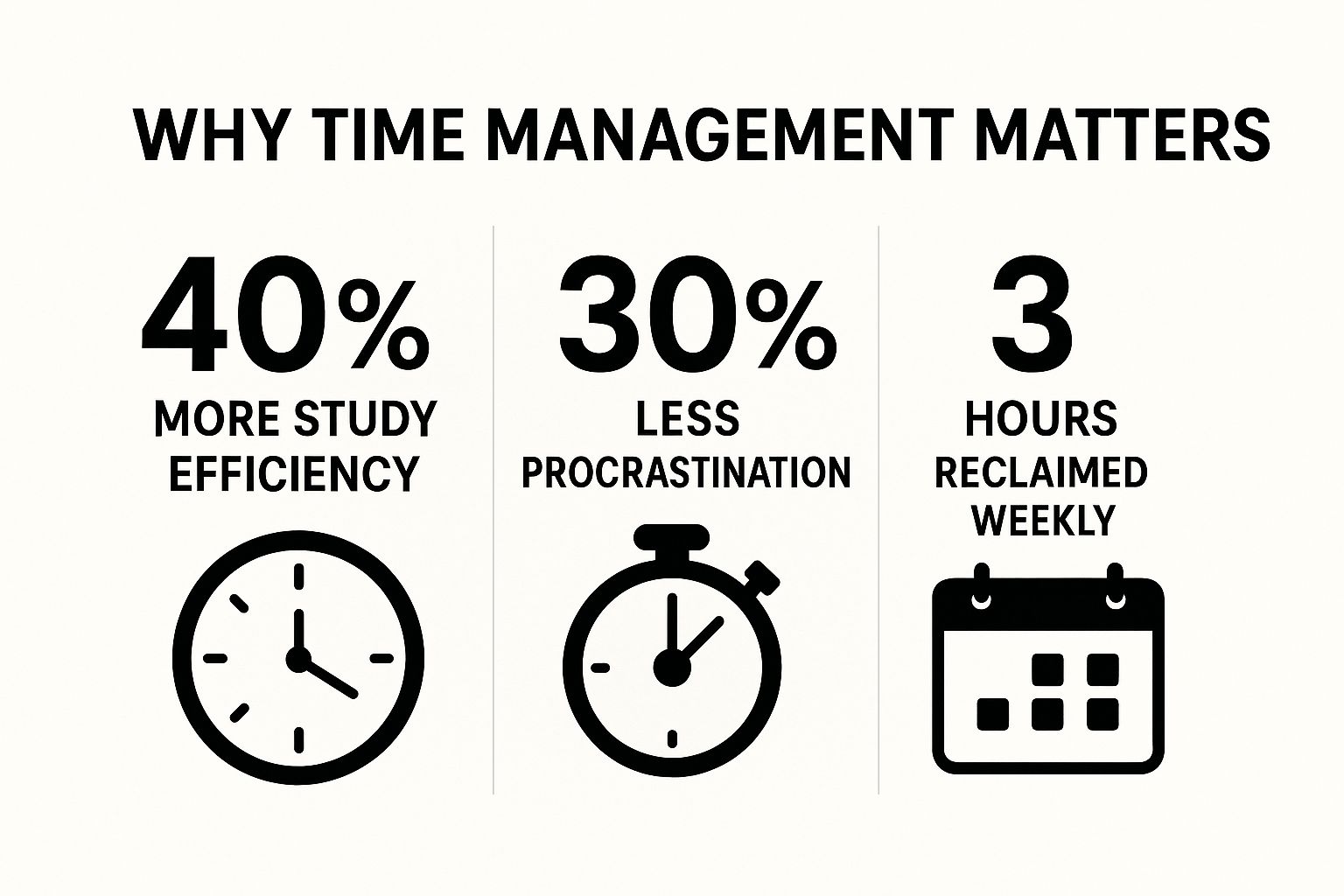
Time Management for Students: Boost Your Academic Success
Share
The Hidden Crisis: Why Students Struggle With Time

Today's students face a significant time management crisis, impacting both academic performance and overall well-being. This isn't simply a matter of laziness; it's a complex issue arising from a number of factors. One of the biggest culprits is the constant stream of digital distractions.
Social media notifications, emails, and the ever-present lure of online content fracture students' attention, making it challenging to concentrate on academic tasks. This means that even when students have the best intentions to study, their focus is often fragmented.
The Digital Deluge and Lack of Preparation
The modern educational system often doesn't adequately prepare students with the essential time management skills they need to succeed. Many students enter higher education lacking a solid foundation in organization and planning. This lack of preparation contributes significantly to the widespread problem of procrastination.
For example, a surprising number of students haven't received any formal time management training during high school, leaving them ill-equipped for the rigorous demands of college or university.
To illustrate the prevalence of procrastination and its impact, let's look at the following table:
Procrastination Statistics Among Students Key data points showcasing the extent of the time management problem in academic settings
| Student Behavior | Percentage | Impact |
|---|---|---|
| Regularly Procrastinate | 75% | Reduced productivity, increased stress |
| Severe Procrastinators | 53% | Significantly impacts academic performance |
| Submit Assignments Within 24 Hours of Deadline (Despite Having a Week) | 58% | Lower quality work, missed deadlines |
| Lack Time Management Training From High School | 47% | Contributes to poor time management habits |
| Earn Higher Grades with Early Submissions | 76% (early submitters) vs. 60% (procrastinators) | Demonstrates the positive impact of effective time management |
This table reveals some concerning trends in student time management. The majority of students procrastinate regularly, with over half classified as severe procrastinators. This behavior often results in last-minute submissions and consequently, lower grades. The lack of prior training in time management further exacerbates the issue.
The Infographic: Visualizing the Struggle
The stats display below visually represents key procrastination statistics among students.

As the stats display demonstrates, procrastination is a significant issue for many students, impacting their academic performance and contributing to a lack of preparedness.
These statistics reveal a critical need for better time management strategies. You can find more detailed statistics at Time Management Statistics. The consequences of poor time management extend far beyond grades. It can lead to increased stress, anxiety, and a decreased sense of accomplishment.
The good news is that time management is a learnable skill. By acknowledging these challenges and adopting effective techniques, students can take control of their time and reach their full academic potential. This raises the important question of why students procrastinate in the first place, a topic we'll explore further.
The Psychology Behind Why Students Procrastinate

Why do so many students, even the high achievers, procrastinate? The answer is more nuanced than simply labeling it as laziness. Complex psychological factors are at work, often stemming from how our brains inherently function. One crucial element is present bias, the human inclination to favor immediate gratification over long-term benefits. This means the quick dopamine hit of checking social media often overshadows the eventual reward of studying for an exam.
Another significant factor is perfectionism. The overwhelming fear of failing to reach exceptionally high standards can be paralyzing. This often leads students to avoid even beginning tasks. Consequently, a negative feedback loop emerges: approaching deadlines amplify anxiety, which then intensifies the procrastination. Recognizing these mental patterns, however, is the first step towards effective time management.
Anxiety, Environment, and the Procrastination Cycle
For many, anxiety is a major procrastination trigger. A difficult assignment can evoke feelings of stress and inadequacy, leading to avoidance as a coping strategy. The academic environment itself can worsen these tendencies. The expectation to excel, combined with the continuous flow of assignments and looming deadlines, can feel insurmountable, making procrastination seem like a viable, albeit temporary, escape.
Furthermore, the lack of early time management training contributes to these struggles. Studies indicate that the absence of early instruction in organization and time management skills significantly impacts students' academic performance. For instance, many students spend less than one hour on coursework daily, resulting in heightened stress and diminished academic results. More statistics on time management can be found here: 105 Time Management Statistics. This underscores the importance of educational institutions providing resources such as campus apps with built-in scheduling tools, which many students find beneficial.
Breaking the Cycle: Understanding Your Procrastination Triggers
Acknowledging the psychological basis of procrastination is the first step towards regaining control of your time. By recognizing how present bias, perfectionism, and anxiety contribute to this behavior, you can begin to develop effective counter-strategies. These may include setting realistic goals, dividing large projects into smaller, manageable chunks, or seeking guidance from academic advisors or counselors. You may also find this resource helpful: How to Master Your Schedule. Ultimately, effective time management begins with understanding your own mind.
Time Management Techniques That Actually Work for Students

Beyond understanding why procrastination happens, let's explore practical time management techniques designed for students. These aren't your average productivity tips; they're research-backed strategies for academic success, helping you work smarter, not just harder.
The Pomodoro Technique: Mastering Focused Bursts
The Pomodoro Technique, created by Francesco Cirillo, breaks down study time into 25-minute intervals called pomodoros, separated by short breaks. After four pomodoros, a longer break is taken. This structure combats procrastination with manageable work periods and prevents burnout. It also trains your brain for intense, short bursts of focus, boosting productivity.
- Step 1: Select a task.
- Step 2: Set a timer for 25 minutes.
- Step 3: Work on the task until the timer goes off.
- Step 4: Take a 5-minute break.
- Step 5: Repeat steps 1-4 four times.
- Step 6: Take a longer break (20-30 minutes).
This technique benefits students with shorter attention spans. Imagine a student writing a research paper: pomodoros could be used for sections like the literature review or methodology, making the project feel less overwhelming. This transforms complex assignments into achievable steps.
Time Blocking: Structuring Your Academic Week
Time blocking involves scheduling specific times for activities. This proactively allocates time for studying, classes, projects, and personal time. It goes beyond a to-do list, assigning specific slots to tasks for better schedule control.
For instance, a student might allocate Tuesday and Thursday evenings for studying, Wednesday afternoons for club meetings, and weekends for socializing and relaxing. Flexibility is important, though. Life throws curveballs, and adjusting your blocks prevents your schedule from being completely disrupted.
Prioritization and the Eisenhower Matrix
The Eisenhower Matrix, also called the Urgent-Important Matrix, is a valuable tool for prioritizing tasks. It divides tasks into four quadrants:
To illustrate the concept, let's take a look at the following table:
Comparison of Time Management Techniques for Students An overview of different time management approaches and their benefits for specific academic scenarios
| Technique | Best For | Implementation Tips | Potential Challenges |
|---|---|---|---|
| Pomodoro Technique | Focused work sessions, combating procrastination | Break down tasks into 25-minute intervals with short breaks | Requires discipline to adhere to the timer, may not suit all tasks |
| Time Blocking | Overall schedule management, balancing various commitments | Allocate specific time slots for different activities, be flexible with adjustments | Can be rigid if not adapted to unexpected events, requires accurate time estimation |
| Eisenhower Matrix | Prioritizing tasks based on urgency and importance | Categorize tasks into four quadrants: Do, Decide, Delegate, Delete | Requires honest self-assessment of task importance, may lead to neglecting less urgent but important tasks |
This table provides a quick comparison of the techniques discussed, highlighting their strengths and weaknesses. By understanding these differences, students can choose the best method or combination of methods for their individual needs.
The Eisenhower Matrix helps students differentiate crucial tasks from those that can wait or be eliminated. By focusing on important tasks, even non-urgent ones, students avoid last-minute cramming and reduce stress. See more about effective scheduling: How to Master Your Schedule. These techniques empower students to manage their time effectively and achieve their academic goals.
Building a Study Schedule That Actually Sticks

Creating a study schedule is often easier said than done. This section explores how to build a schedule that truly works for you, instead of becoming just another source of stress. The secret lies in honestly assessing how you currently spend your time.
Conducting a Personal Time Audit
Before creating a schedule, perform a time audit. Track your activities for a week, noting the time spent studying, attending class, working, socializing, and relaxing. This exercise often reveals surprising differences between perceived and actual time allocation. This awareness is essential for building a practical schedule. You might find, for example, that social media consumes a significant portion of your day, impacting available study time.
Choosing the Right Scheduling Philosophy
Different schedules suit different people. Some students thrive on fixed block systems, dedicating specific times to specific activities each day. Others prefer a flexible framework, adjusting their study time around other commitments. The ideal approach aligns with your learning style and lifestyle. A flexible approach might be more suitable if your classes or work schedule varies weekly. However, if procrastination is a challenge, fixed blocks can provide much-needed structure and accountability.
Semester Mapping: Preventing End-Term Crises
Look beyond weekly schedules and consider semester mapping. This involves outlining major assignments, projects, and exams for the entire term. This practice helps anticipate busy periods, allocate sufficient time for larger tasks, and avoid last-minute cramming. Imagine mapping out a research paper: you could break it down into smaller steps like topic selection, research, drafting, and editing, assigning each step to specific weeks. This distributes the workload effectively, reducing end-of-semester stress.
Building in Flexibility and Recovery
Life rarely goes exactly as planned. Incorporate buffer time into your schedule for unexpected events. Also, include recovery strategies for when you inevitably fall behind. This could involve dedicated catch-up sessions or adjusting the following week’s schedule. This approach acknowledges that successful scheduling isn't about rigid adherence, but adaptable planning. A realistic schedule, accounting for life's disruptions, promotes consistent adherence. For additional tips and resources, check out the Boss Personal Planner. By prioritizing balance and flexibility, you create a sustainable study schedule that supports both academic success and overall well-being.
Digital Tools That Transform Student Productivity
Creating a solid study schedule is essential. However, using the right digital tools can significantly improve your time management. The sheer volume of apps available can feel overwhelming. This section will guide you in selecting the right tools to enhance your academic life, not complicate it.
Task Management Platforms: Taming the Chaos of Coursework
Juggling assignments across multiple subjects can be a challenge. Task management platforms provide a central hub for organizing your academic to-dos. They offer more than simple to-do lists, allowing you to categorize tasks by subject, set deadlines, monitor progress, and even collaborate with classmates.
-
Features to look for:
- Project Breakdown: Break down large projects (like research papers) into manageable steps.
- Deadline Reminders: Receive notifications for upcoming deadlines, avoiding last-minute stress.
- Cross-Platform Synchronization: Access your tasks from any device, staying organized on the go.
Calendar Applications: Optimized for Academic Scheduling
Many students use digital calendars, but few maximize their potential for academic life. Your calendar should be more than just class times. Use it to schedule study sessions, set project milestones, and track deadlines for extracurriculars. This gives you a comprehensive view of your commitments, helping you visualize your week and proactively manage potential conflicts. You might find this helpful: How to Master Your Schedule.
-
Tips for Effective Calendar Use:
- Color-Coding: Assign colors to different event categories (classes, study time, social events).
- Recurring Events: Schedule recurring events for weekly study sessions or club meetings to maintain consistency.
- Time Blocking: Dedicate specific time blocks for focused work, minimizing interruptions and maximizing productivity.
Focus Apps: Combatting Digital Distractions
The internet is a valuable resource for students, but it can also be a major source of distraction. Focus apps help you regain control of your attention by temporarily blocking distracting websites and apps. This creates a digital environment that promotes focused studying and enhances productivity.
-
Benefits of Focus Apps:
- Increased Concentration: Minimize the urge to check social media or browse unrelated websites.
- Improved Productivity: Complete assignments more efficiently without constant interruptions.
- Reduced Procrastination: Foster a digital environment that encourages focused work.
Integrating Your Digital Toolkit: A Unified System for Success
The key to using digital tools effectively is integrating them into a cohesive system. Link your task management platform to your calendar to view scheduled tasks and deadlines at a glance. Use focus apps during dedicated study blocks to minimize distractions and improve concentration. This synergy allows each tool to complement the others, creating a unified system for effective time management. Ultimately, this lets you focus on your academic goals, not managing apps.
Balancing Academic Excellence With a Life Worth Living
Striving for academic excellence is a commendable goal. However, it shouldn't come at the expense of your overall well-being. This section explores how to maintain a healthy balance between academic pursuits and a fulfilling life outside of your studies. It’s about finding a sustainable rhythm that allows you to succeed academically without sacrificing your physical and mental health. Many high-achieving students have learned this lesson the hard way, experiencing burnout from overcommitment and neglecting their personal needs. You can learn from their experiences and avoid similar pitfalls.
Evaluating Extracurricular Commitments: Value vs. Resume Padding
Extracurricular activities can enrich your college experience, but choosing them wisely is crucial. Instead of joining numerous clubs just to enhance your resume, focus on activities that genuinely align with your interests and values. Ask yourself: Does this commitment bring me joy? Does it contribute to my personal growth?
If the answer is no, it might be time to re-evaluate. For example, if you are passionate about environmental sustainability, joining the campus environmental club would be more fulfilling than participating in a club that doesn't resonate with you, even if it seems more prestigious. This focused approach allows you to invest your time and energy in activities that genuinely matter, preventing burnout and enhancing your overall well-being.
Integrating Self-Care: Essential, Not Optional
Self-care is not a luxury; it's a necessity, especially for busy students. Integrating self-care practices into your routine is crucial for maintaining both physical and mental health. Consider these key areas:
-
Sleep Optimization: Aim for 7-9 hours of quality sleep each night. Establish a regular sleep schedule, even on weekends, to regulate your body's natural sleep-wake cycle. This will improve cognitive function, memory consolidation, and overall academic performance.
-
Physical Activity: Incorporate short bursts of exercise into your day, even if it's just a brisk walk between classes. Physical activity boosts energy levels, reduces stress, and improves focus.
-
Social Connection: Make time for meaningful social interactions with friends and family. Strong social connections provide emotional support and combat feelings of isolation, contributing to better mental health.
These practices aren't time-wasters; they are investments in your well-being that enable you to perform better academically and enjoy a more balanced life.
Setting Boundaries and Communicating Effectively
Learning to set boundaries is crucial for protecting your time and energy. This means saying no to commitments that overextend you and communicating your limitations effectively. Don't be afraid to tell your professors or peers if you need an extension or require assistance.
For instance, if you feel overwhelmed by multiple deadlines, consider talking to your professors about adjusting due dates or exploring tutoring resources. This proactive approach allows you to manage your workload realistically without jeopardizing your well-being. Remember, prioritizing your mental and physical health isn't a sign of weakness; it's a strategy for long-term success.
For a comprehensive planning solution to help manage your time and prioritize self-care, check out the Boss Personal Planner. This tool provides a structured approach to scheduling, goal-setting, and habit tracking, empowering you to balance academic excellence with a fulfilling life.
